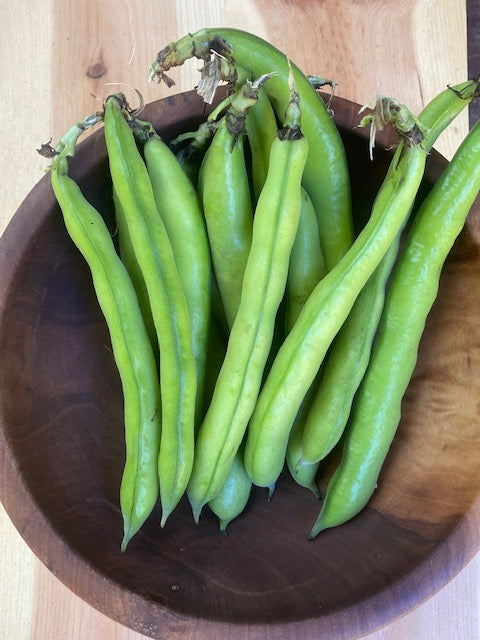Siskiyou Seeds is located in a small town called Williams. We have a vibrant local community that includes lots of gardeners, crafts people and folk in agriculture. On Monday I was at our local farmers market which is an active community hub and one of my favorite places to shop for extra produce. I like to buy vegetables that I do not have in my garden from the farmers market. It can be difficult to grow everything you want to eat due to limitations in time, skill and gardening space.
Luckily, my favorite local farmer always grows some interesting vegetables that I do not have in my garden. This week I purchased a pint of fava beans from her. I realized while talking to her I had never eaten fresh fava beans before. Sure I have had dried cooked fava beans but never fresh ones. Fresh fava beans have a short harvest window and are difficult to find in regular grocery stores.
I have grown favas before but always as a part of a cover crop mix, not as a food crop. These favas tend to get tilled in to make room for summer crops. Favas are a great cover crop because they fix nitrogen into the soil, an essential nutrient for plant growth. But they are also an excellent food source. It is great when a plant helps build soil in your garden and can also feed you!
So how do I turn these bright green thick fava bean pods into lunch today? I decided to ask a friend who is a chef for advice. He was very enthusiastic about my journey into cooking fava beans.
His advice was as follows. First, shell the fava beans from their pods. Then, blanch the beans in salted water. After that, just saute them in a pan with olive oil, garlic and salt. It seems so very simple. I love learning easy and basic ways to prepare vegetables. The less complicated a recipe is, the more the flavor of a vegetable can shine through.
How To Prep Fava Beans:
First, shell the fava beans from their pods. This is fairly easy. You should be able to split the pod in two along its seam.

Use your thumbs to open up the pod and then run your finger through the pod to detach the beans from the inside.

Once you have all of your beans shelled. Place 2 quarts of boiling water on the stove. Once it is boiling add a ¼ teaspoon of salt. ( The salt is optional, there are varying opinions on whether adding salt helps make removing the beans from their outer shells easier or not. I chose to use salt)
Add the fava beans to the boiling water and let them boil for one minute. Strain the beans from the water into a bowl. Then cover them with cold water.

Once they have cooled down, peel the outer shell of the beans to reveal a bright green fava inside. This step is also optional. Leaving on the outer shell can lend a nice touch of bitterness to the mellow taste of the inner bean. I chose to remove the outer shell but this is a personal choice. They are delicious either way.

How to Cook Fava Beans:
- Heat one tablespoon of olive oil in a pan.
- Chop one clove of garlic and add it to the heating olive oil.
- Add your fava beans into the pan.
- After about five minutes sprinkle on some salt, about ¼ teaspoon.
- When the beans start to slightly change color add the juice from a ¼ of a lemon. This will add some brightness in flavor.
- Stir as needed.

The favas will be done after about ten minutes. You can eat them as a side dish or mash them on some crusty sourdough toast. I added the cooked fava beans to the top of simple ground lamb tacos and found it to be a truly delicious combination.

There are lots of excellent ways to make fava beans. Let us know in the comments if you have any great fava bean stories or recipes to share. We like you, are always curious and excited about ways to bring more vegetables into our gardens and onto our tables. Enjoy!
Article by Taryn Hunter


Sandy Irber
Thank you so much for the fava bean recipe! I am growing them for the first time, and some are ready for harvest. Mashed on lamb tacos sounds divine!
Thanks,
Sandy
Nevada City